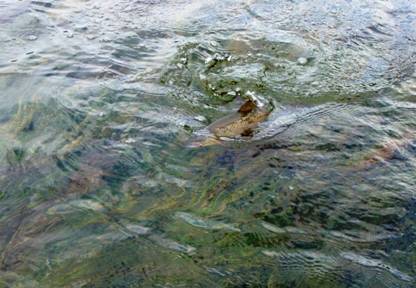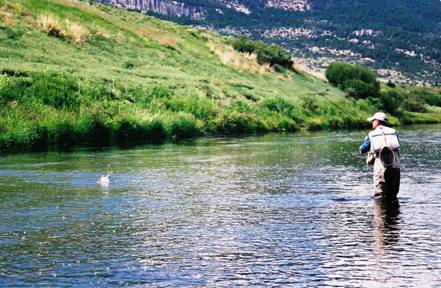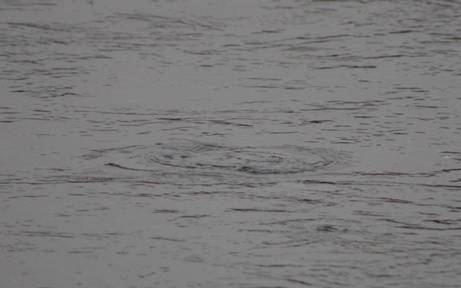EVENINGS ALONG THE STREAM (part 5)
| Sysadmin Note |
|---|
| Part Four can be found here |
June 26th, was to provide us with a normal PMD Hatch that occurred at the normal time, however the spinner fall would provide some valuable lessons and it is those lesson which I will now share with you in the form of a fly fishing puzzle.
A FLY FISHING MYSTERY IN THE CASE OFTHE WET SPINNER
Taking a page from the famous Sherlock Holmes, created by Sir Arthur Conan Doyle, "Ah, the mystery is afoot in the case of the Wet Spinner".
Before I delve into the story I would like to share an observation with you.
I have read countless books and magazines over the past fifty years, and have listened to countless discussions on the art of fly-fishing, and the one thing that stands out, is how some rule applies to a certain situation. My observation is this: Rules are made by people for trout fishing situations; however, the trout have had no say in the construction of these rules.
Therefore, for me, the rule is that there are no rules when facing an angling situation. There are only solutions!
In the classic book entitled Fly Fishing, by Viscount Grey of Fallodon, published in 1899, revised and enlarged in 1934: On page 87 Lord Grey wrote; "I have known and tried enough of the wet fly to be sure that the use of it has very narrow limits in a pure chalk stream well fished." Statements like this are innocent by themselves. However, many anglers would thus leave their wet flies to home when fishing a chalk stream or spring creek, and as you will see as the story unfolds, leaving the wet flies to home would have been a major mistake.
The lesson to be learned is that the author is basing his comments on his or her experience and observations based at the time the selection was being penned. It does not mean that wet flies never work on Chalk Streams or Spring Creeks. In the world of fly fishing nothing is ever cast in stone, as fly fishing for trout is an ever changing and fluid endeavor. As a point of information, I would tell you that during his later years Lord Grey became blind and returned to fishing wet flies most of the time. Complacency is a trap that any angler or guide can step into. The trick for escaping this trap is observation and an active mind.
Well, on the evening in question, at first I was seeing, but not observing, and my mind had left to go off wandering over another situation we had encountered earlier in the day. Good guides are their own worst critics. Regardless of the fact that we had enjoyed an exceptional fishing day, where challenges were met, situations were solved, and trout were taken in reasonable numbers, I still was reviewing what I could have done different. For the past twenty minutes the spinners were falling and the trout were actively feeding, but we were without hook-ups. I didn't understand. We were facing a known situation where generally the methods and patterns were extremely effective. But, not today!
I think I should back up and explain the mystery, the lesson learned and the solution in a straightforward manner. It was late June and we were fishing the Pale Morning Dun spinner fall on DePuy's Spring Creek in Paradise Valley, just south of Livingston, Montana. This time period is known as a "Prime Time" period for this hatch on the Spring Creeks. The PMD hatch begins around mid-June and will continue until late August. However the period from June 24th to July 10th is loosely known as the prime time period where the emergence and spinner falls are the heaviest and most dependable. Normally, once the spinners begin to show, you can select one of the three spinner imitations that I recommend and proceed to take trout at a very steady rate.
Now, this success does depend on one's ability to cast, set the hook and fight the trout in the proper manner. But that aside, the spinner falls are always one of the prime time highlights of the day.

That is until today. Oh, we were seeing rise forms and the trout were taking spinners, however not the ones we were offering. Yes, occasionally we would hook a trout, but they were few and far between. We switched patterns, adjusted tippet and checked the surface film to make sure we knew what the trout were eating. We had pumped a couple of stomachs of the hapless trout we did take and knew that they were taking size 18 PMD spinners. But not the ones we were using. Both of the clients I was fishing with were exceptional anglers who had many years of spring creek experience and had, in fact, successfully fished this same spinner with success during the previous two evenings. So, what was different today?
After leaving my vest on the bank, I eased into the shallow water and carefully approached a feeding trout (Rainbow) that I could clearly see. For several minutes I watched this trout take spinner after spinner, when it suddenly dawned on me. Sure I was seeing the trout feed on spinners and there were rise forms everywhere, but they were not taking the spinners off the surface of the water. They were taking them just beneath the film!
They were eating drowned or wet spinners. After all of the frustration we had been suffering, I'm afraid that my oath of discovery was a little loud, as both of the clients came to see what I was so excited about. I took the time to show them what was going on, and all three of us watched the trout feed on the sunken spinners.

Guiding for me is more than just catching the trout. It is teaching and sharing the knowledge with the anglers who choose to fish with me. I had a few soft hackled PMDs with me and we managed to take a few fish that evening with a little more consistency as the spinner fall began to fade out for the day. The lesson was that we saw the rise forms, but I didn't give them the proper attention until they slapped me in the face with their refusals of our offerings. The days during late June are quite long and we didn't leave the creek until 10:00 PM. We all stopped for a late dinner and discussed what had transpired.
They were happy with the final solution, but I was dissatisfied with the soft hackles and I felt that a truly wet spinner imitation would have been more effective. Well, I was up until 2:00 AM in the morning getting ready for a rematch, checking my fishing journals to see how many other times I had encountered this situation, and what I had done to remedy the situation. Part of the solution was to tie two types of wet spinner imitations to try if I encountered this situation again. The next day, and for several days thereafter, we had excellent fishing and a standard spinner fall where the trout were clearly feeding on the surface. So the patterns went untested. Finally, the two brothers were ending their trip, one was returning home but the other one was staying on to fish with me for three more days.
These guys are great. They are the type of client that every good guide needs, as they always want to learn more and improve their skills and their understanding of situational angling problems. They push me to learn more and become better than I am, so I can share the knowledge with them.

On our first day alone, we once again encountered the strange feeding behavior where the water was covered with spinners but the trout were feeding on those spinners that were beneath the surface of the water. We used both types of spinners and did very well with them. Since the days of that lesson I have encountered that feeding behavior many times on many different waters. I would like to share with you the patterns we used that were very effective. Besides the two wet PMD Spinners, I will also share a couple other recipes with you that apply to other western hatches.
Wet Spinner Imitations Style One
PMD Wet Spinner Style One
- Hook: TMC 101
- Sizes: 16-20
- Thread: Rusty or Sandy Dun 8/0 or 12/0
- Tails: Lite Dun wet hen hackle fibers, tied long
- Abdomen: PMD Turkey Biot, wrapped
- Thorax: PMD Dubbing. I prefer muskrat or beaver, something that when untreated will soak up a little moisture.
- Hackle: Lite Dun wet hen hackle, tied as a collar, with only 2 to 3 turns
Note: I want this imitation to be wet and sink slightly beneath the surface, therefore I get it wet and soaked with water before I begin casting. Once again, remember this is a wet fly. Try keeping the number of false casts down to the bare minimum required to present the fly to feeding trout. You will be targeting a feeding trout; you will be reacting and making the hook set on the visible fish or the rise form. Hey, even if you were fishing a dry fly you might not be able to see the fly on the water as the light fades. Therefore, react to the fish. Trust me, it works. I also might mention that I like my collar hackle to be a little long, say a half size over what is needed.
Rusty Wet Spinner Style One
- Hook: TMC 101
- Sizes: 16-20
- Thread: Dark Dun or Camel 8/0 or 12/0
- Tails: Lite Dun wet hen hackle fibers, tied long
- Abdomen: Rusty Turkey Biot, wrapped
- Thorax: Dubbed, Rusty muskrat or beaver fur
- Hackle: Lite Dun wet hen hackle, wrapped as a collar, with only 2 or 3 turns
Note: PMD Spinners can be found in two color variations, on the Spring Creeks in Paradise Valley. The males are the ones which are PMD or Pale Olive in color and the females are Rusty in color.
This style of spinner imitation can be tied in many different color combinations to match the spinners found on the water that you fish. They are simple to tie and effective to fish. Here is another of my favorite recipes.
Callibaetis Wet Spinner Style One
- Hook: TMC 101
- Sizes: 14-20
- Thread: Dark Dun 12/0
- Tails: Grizzly wet hen hackle fibers, tied long
- Abdomen: Muskrat Gray Turkey Biot, wrapped
- Thorax: Dubbed, natural Gray Muskrat Fur
- Hackle: Grizzly wet hen hackle, tied as a collar, with 2 or 3 turns
Note: I also tie this pattern in size 12 and use it as a wet Gray Drake Spinner. I have often encountered the trout feeding on sunken Gray Drakes on the Upper Yellowstone River in Yellowstone National Park and on the Lamar River and Slough Creek, also in the Park.
Wet Spinner Imitations Style Two
Where style one is nothing more than a wingless wet fly, style two does look like a conventional spinner, except that it is tied with materials that will allow it to sink beneath the surface of the water. This pattern has also proven to be quite effective, though it is a little more difficult to tie. But all it really takes is practice.
Pale Morning Dun Wet Spinner Style Two
- Hook: TMC 101
- Sizes: 16-20
- Thread: Rusty or Sandy Dun 8/0 or 12/0
- Tails: Lite Dun wet hen hackles, tied long
- Abdomen: PMD Turkey Biot, wrapped
- Wings: Lite Dun wet hen hackle, wrapped in the wing position and then the fibers are gathered into two bundles on either side in the spent position and posted: which is done by wrapping thread around the base of each wing. I use one size larger hackle for this type of imitation so that the wings will be the proper size.
- Thorax: Dubbed, with muskrat or beaver fur, dyed PMD
Note: The posting of the wings keeps them from folding back along the body, thus ensuring the proper silhouette of the spinner that is barely sunk beneath the film.
Rusty Wet Spinner, Style Two
- Hook: TMC 101
- Sizes: 16-20
- Thread: Dark Dun or Camel 8/0 or 12/0
- Tails: Lite Dun wet hen hackles, tied longAbdomen: Rusty Turkey Biot, wrapped
- Wings: Lite Dun wet hen hackle, one size larger, wrapped and divided, posted and tied spent.
- Thorax: Dubbed, with Rusty muskrat or beaver fur
Callibaetis Wet Spinner, Style Two
- Hook: TMC 101
- Sizes: 14-20
- Thread: Dark Dun or Gray 8/0 or 12/0
- Tails: Grizzly, wet hen hackle fibers, tied long
- Abdomen: Muskrat Gray Turkey Biot, wrapped
- Wings: Oversized Grizzly wet hen hackle, wrapped and divided, posted and tied spent.
- Thorax: Dubbed, natural gray muskrat fur
Note: Remember, I also tie this in size 12 for the Gray Drake Spinner.
In closing, I might mention that I also use these imitations at other times besides the spinner falls. Often during an emergence, I will use a sunken spinner to imitate the stillborns and drowned adults that will be on the water.
Also remember that these wet flies are designed to be used when working over visible feeding trout. Sometimes I am casting to a rise form, as the light will not permit me to see the fish clearly. But with these patterns, I also am not employing standard down and across wet fly method.
Therefore, the next time you are fishing a spinner fall and the trout seem to be ignoring your dry flies, give wet spinners a try, they work for me.
Most of what we encounter when trout fishing is solving situational angling problems. I hope you have enjoyed this one and I hope the information will aid you on the stream.
Enjoy & Good Fishin'
| Sysadmin Note |
|---|
| Part Six can be found here |
